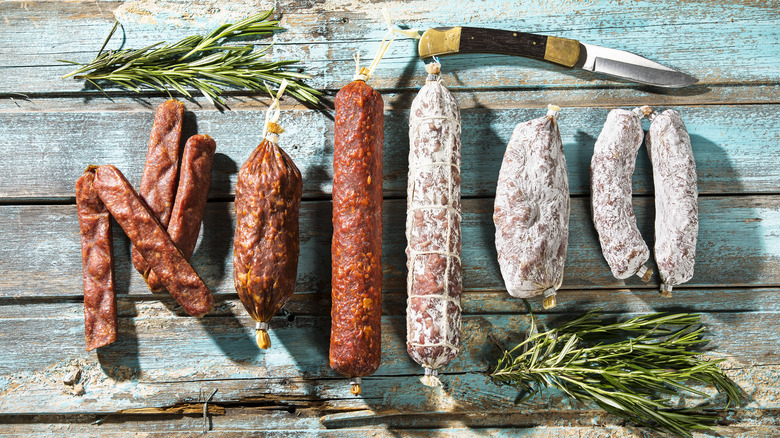What's The Difference Between Old World Pepperoni And The Regular Kind?
If you ask the average person to explain the difference between regular pepperoni and Old World pepperoni, they might come up short — it's not exactly common knowledge. But show them two pepperoni pizzas, one topped with regular and the other with Old World, and they'd spot the difference immediately. More than that, they'd probably be able to explain it as well. Regular pepperoni is the kind most of us remember from childhood, the kind served at pizza chains and most small-town pizza joints, the kind that comes pre-sliced in a plastic bag at the grocery store. It's generic pizza pepperoni.
Old World pepperoni may also be recognizable, at least these days: In recent years, it's taken the pizza world by storm. Old World pepperoni tends to be smaller in diameter than regular pepperoni, and it's usually sliced a bit more thickly. This type is also known as cupping pepperoni, or cup and char pepperoni, for the way that it cups (and chars) around the edges when blasted in the high heat of a pizza oven, forming little bowls that trap delectable hits of meat grease — which some folks have taken to calling roni cups. Both regular and Old World pepperoni have Italian roots, though neither is fully a product of the Old World, names notwithstanding. Pepperoni itself is a delicious American creation.
Where Old World pepperoni comes from
Flat pepperoni is a calling card of the New York slice joint, but Old World may come from elsewhere in the country. It might even be the original American pepperoni, since it relies on a natural casing — something that went out of style as food manufacturers switched to artificial casings, which don't allow for as much cupping action. But Old World pepperoni held on in places like Buffalo and the Midwest. One reason for its recent resurgence might be that one of the best-known purveyors of cupping pepperoni, Ohio-based Ezzo Sausage Company, started distributing in New York in 2016, and soon the product was showing up at popular restaurants like Emmy Squared. According to one theory, the inclusion of beef in pepperoni, and its smokier flavor than some other Italian sausages, also testifies to Midwestern links — specifically, the influence of the region's German-Americans. It's not the only local spin on this sausage: See also the beloved West Virginia pepperoni roll.
What accounts for Old World pepperoni's cup-ability? In a deep dive, food science expert J. Kenji López-Alt tried out a few different theories, finding that natural or collagen casings promoted cupping, as did meat sliced medium-thick: roughly, between a tenth and a quarter of an inch. Of course, as a general rule, it's hard to go wrong with pepperoni — thick, thin, flat, or cupped. But properly prepared Old World pepperoni shows that it's also possible to go very right.
How pepperoni was invented in the US
Now we know the difference between Old World and regular, but what makes pepperoni ... pepperoni? This dried sausage is typically made from ground pork and beef, which are mixed with spices like garlic and paprika, then stuffed into a casing and air-dried. As with other sausages, casings were originally made from animal intestines, but these days different options are available — like cellulose casings, which aren't edible, and collagen casings, which can be. Compared to other Italian cured meats, pepperoni comes out a little softer, with a striking red hue.
That difference may be attributable to the fact that pepperoni is a distant cousin to its Italian relatives. Though it comes from Italian sausage-making traditions, "pepperoni" itself isn't something served in Italy, where the word "peperoni" refers to big sweet peppers, like bell peppers. This specific type of sausage was invented in the U.S., with the first printed reference emerging in 1919, in an era when butcher shops operated by Italian-American immigrants began appearing in New York and other cities. Pepperoni resembles some chile-studded dried salamis made in Italy, though food historians have speculated that immigrants here used paprika instead because it was available and affordable — lending pepperoni its trademark smokiness.


